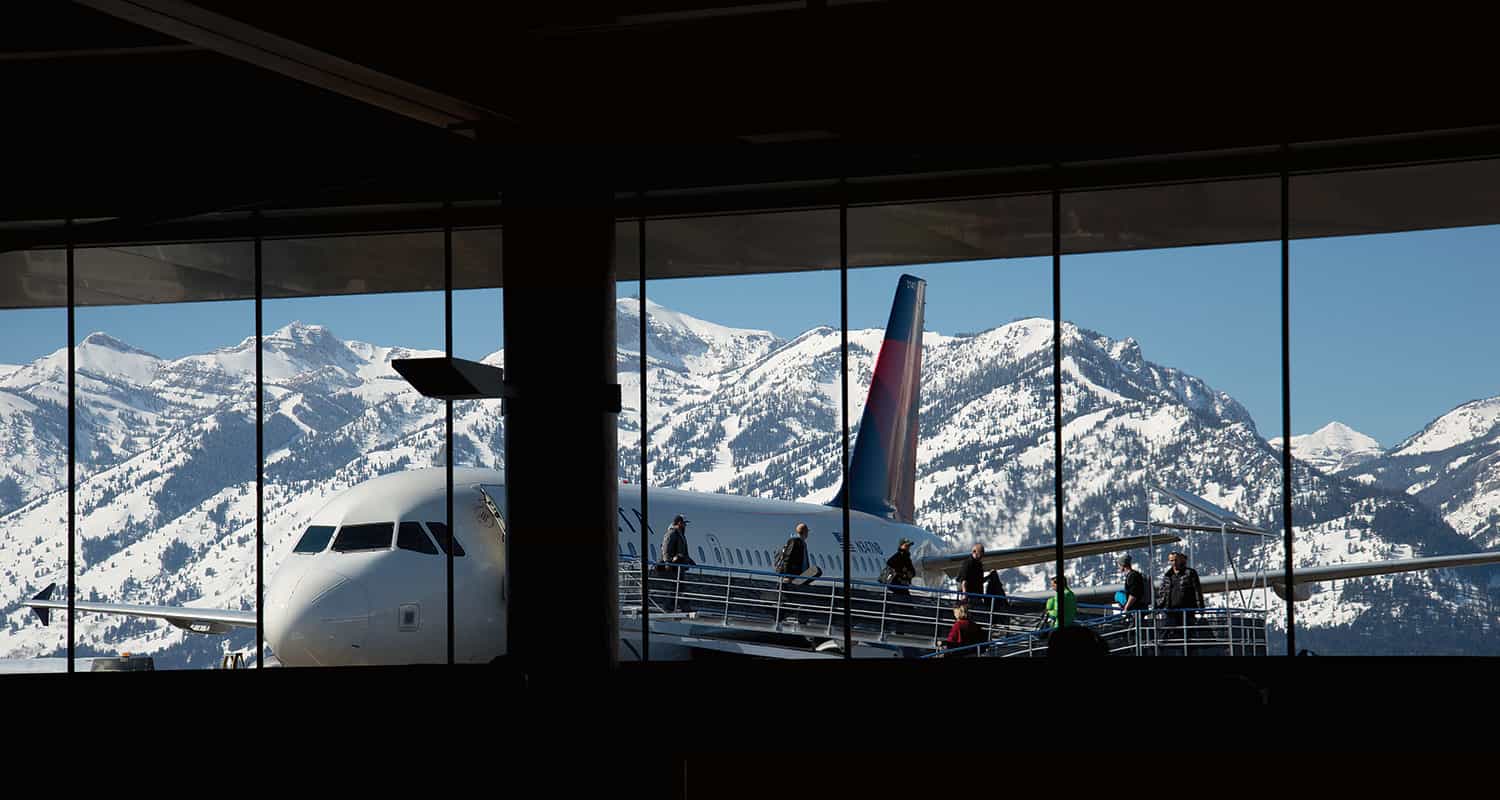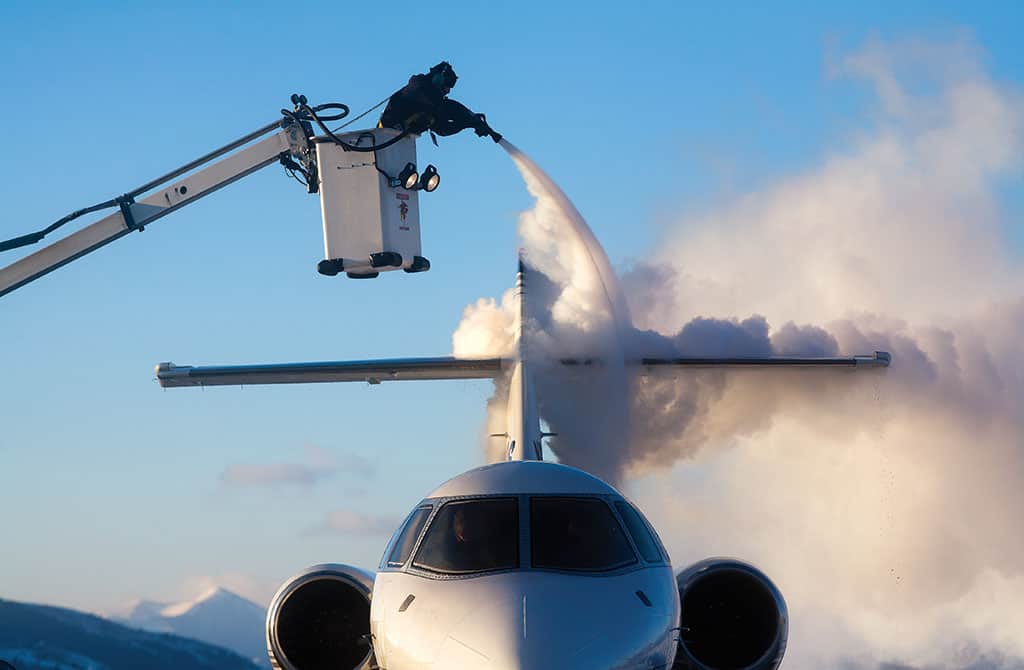Read The
Current Issue
Airport Helps Jackson Hole Soar
The valley’s economy would be very different if it weren’t for our newly remodeled and expanded airport. It doesn’t hurt that it’s one of the most beautiful in the country, inside and out.
By BEN GRAHAM

THE JOKE USED to be that flights from Salt Lake City to Jackson Hole were shorter than the wait at the baggage claim once you arrived. The flights, run by Delta/SkyWest, take about thirty-five minutes and, along with Denver, account for most daily arrivals at the Jackson Hole Airport (JAC).
While the anecdote was not necessarily accurate, the underlying message was clear: people needed to get their luggage quicker. “It’s part of the customer experience,” says Jim Elwood, director of the Jackson Hole Airport. “It needed additional ability to handle the number of people using the airport.”

That was the reasoning behind the airport’s $21 million terminal overhaul and baggage claim expansion. The new baggage wing, which opened in December 2014 after more than a year of construction, includes four luggage belts; pre-expansion, there were just two. Because the airport might have some of the best views of any in the United States—it is the country’s only airport inside a national park—the overhaul also added panoramic windows that offer sweeping vistas of the Teton Range, from Mount Glory in the south all the way north to the Grand Teton and beyond. The departure area has contemporary furniture, from armchairs upholstered in raw cowhide to sleek leather sofas, and also a two-sided gas fireplace. The main terminal includes oversize artwork by Richard Painter. Elsewhere in the terminal are pieces by Z.S. Liang and Nelson Boren, both nationally renowned artists represented by galleries in Jackson. Elwood is particularly fond of Boren’s painting of a moose calf seated amidst a row of cowboy boots. “The eyes follow you as you walk,” he says. “It’s like the Mona Lisa of moose.”
The baggage and terminal projects are the main components of a series of expansions that have transformed this once-dusty air strip into a travel hub that is now not only the most beautiful airport in Wyoming but also the busiest airport in the state—the Jackson Hole Airport accounts for more than half of all the state’s commercial airline activity.
Over the last six years, $28.6 million was spent on projects that included new airline ticket counters and outbound baggage facilities, runway improvements ($5 million), and the installation of new runway lights ($3 million). There was also $6 million invested in infrastructure that allows the airport to capture glycol, which is used to de-ice planes, before it runs off the tarmac and seeps into the ground.

The investments in the airport have bolstered its standing, making it more appealing to airlines and passengers alike. Over the last several years, the number of cities with nonstop flights to Jackson Hole has doubled. During the ski season, there are direct flights to/from thirteen airports: Salt Lake City, Denver, Chicago, Los Angeles, Dallas/Fort Worth, JFK, Newark, Atlanta, Seattle, Minneapolis, Washington Dulles, Houston, and San Francisco. Jackson Hole is now the No. 1 ski resort for access in the Rockies.
During the ski season, there are direct flights to/from thirteen airports: Salt Lake City, Denver, Chicago, Los Angeles, Dallas/Fort Worth, JFK, Newark, Atlanta, Seattle, Minneapolis, Washington Dulles, Houston, and San Francisco.
THE INCREASE IN flights isn’t only the result of airport improvements. It is, in fact, mostly due to Jackson Hole Air Improvement Resources (JH AIR). This nonprofit organization uses money from valley businesses—most often those that rely on tourist dollars—and government money to provide minimum-revenue guarantees for airlines.
Additional winter flights have proven to be a boon for businesses beyond the obvious one, Jackson Hole Mountain Resort (JHMR). “Oh god, it’s huge,” says Scott Sanchez, store manager at JD High Country Outfitters, which sells outdoor gear for sports from hunting and fishing to skiing at its shop on the Town Square. “Direct flights work,” he says. More frequent and direct flights allow people to jet in for just a long weekend, which wasn’t always so easy. “There are a lot of people you talk to who are basically coming from the hubs,” Sanchez says. “A lot of people come for a few days, which wasn’t really an option when it took a whole day to get here. It’s not cheap to get in here, but [now] it’s easy.”
The most recent JH AIR Jackson Hole Airport Passenger Survey, from the winter of 2014-15, found that the option of flying direct played a large role in visitors’ decisions to come to Jackson Hole. Asked to rate the importance of nonstop flights on a scale of 1 to 10, passengers on average gave it an 8. Slightly more than half of passengers rated it a 9 or 10.
All of the investment and planning has helped the airport power Jackson Hole’s economy, although Elwood says he prefers to think of it as an “economic responder” rather than an economic engine. “What we’re doing is simply giving a portal for people to arrive and depart from this community,” he says. This includes locals. As recently as ten years ago, locals looking for a break from winter had a difficult time flying out because of both the fewer number of daily flights and the number of connections required. In summer, when flights have always been more frequent, it could be difficult for locals to find a seat at a reasonable price (although the argument could be made that it’s still difficult to find an inexpensive seat). Today, “For those of us who want to get out of here sometime in the winter, the more and better flights are important,” says Jerry Blann, the president of JHMR and one of the five members of the Jackson Hole Airport Board, which governs the airport.
Passenger numbers were actually down slightly this past summer (only by 1 percent, though) when compared with the year before, but traffic in general is up. Jackson Hole Airport saw its busiest year on record in 2014, when more than 313,000 visitors arrived/departed on commercial jets. That was a 2.5 percent increase over the previous record—306,000 passengers—set in 2008. “That [2014] was a record passenger year for the airport and, in recent years, the growth has been occurring in winter travel,” Elwood says.
Each of those new visitors spends money at valley hotels and shops. During the summer of 2014, tourists who came to Jackson Hole through the airport spent an average of $254 each day, according to the passenger survey in which departing passengers self-report their activities while visiting the valley. Air passengers pumped an estimated total of $269 million into the valley’s economy that summer. The winter of 2013-14, the average spent per day was $326, for a total of $130 million that season.
THE JACKSON HOLE Airport Board is under the purview of the Jackson Town Council and the Teton County Board of Commissioners. Politicians appoint community members who serve as volunteers. It is this board that hired Elwood, who has been the airport’s director since September 2014. (Previously, Elwood was the director of the Aspen/Pitkin County Airport in Colorado.) JHMR president Blann is the longest-serving member in the board’s history. There is no official limit on the number of terms a member can serve, but traditionally members move on after two terms. Last year, local government appointed Blann to a fourth consecutive term. A recent study showed that 85 percent of winter visitors—83 percent of whom ski at least one day at JHMR—arrive by air. “The summer is still more than half of the total passenger activity of the year,” Elwood says. “But summer numbers have been relatively flat since 2008. Summer has been a relatively mature market at the airport; there’s room for growth in the winter market, though, and that’s a beautiful time to visit the area. We want to help people get here.”
How Grand Teton National Park Ended Up with an Airport
THE TOWN BUILT the Jackson Hole Airport at its present location in the 1930s, before the land it sits on was part of Grand Teton National Park. And by “built” we mean it was an unpaved landing strip. Commercial air service—Western Airlines flew DC-3 propeller aircraft into the valley—began in the early 1940s. Planes landed on the simple, short dirt runway until 1959, when a 6,300-foot runway was built. (By this time, the land the airport was on was part of the park; the airport got a lease on it that ran through 1995.) By the late 1960s, the town and county formed a joint board to oversee the airport’s operations; this board still runs things today.
In the late 1970s, the National Park Service (NPS) announced that the airport would close when its lease ended in 1995. This was great news to the valley residents who viewed it as an intrusion on park values. But under James Watt, a Wyoming native and Secretary of the Interior for the Reagan administration, the Federal Aviation Administration was strengthened while the NPS’ control over the airport was weakened. Instead of being relocated, the airport signed a new lease that extends well into the twenty-first century.




